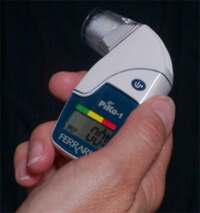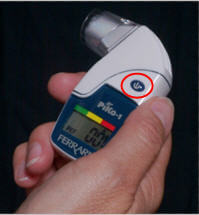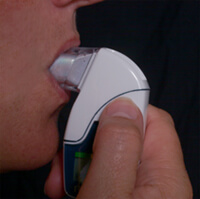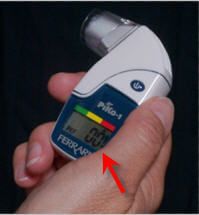Piko Peak Flow Meter
 The Piko peak flow meter is a small, easy-to-use instrument that enables you or your child to measure lung function at home, at work, at school—wherever you go. The peak flow meter measures how fast a person can blow out air after a maximum inhalation. It helps reveal how well you or your child's lungs are working. The Piko measures PEF. This is the peak expiratory flow rate. In addition, the Piko also measures FEV1. This is the Forced Expiratory Volume in the first second you exhale. Many peak flow meters measure PEF, but not FEV1. The Piko peak flow meter measures both.
The Piko peak flow meter is a small, easy-to-use instrument that enables you or your child to measure lung function at home, at work, at school—wherever you go. The peak flow meter measures how fast a person can blow out air after a maximum inhalation. It helps reveal how well you or your child's lungs are working. The Piko measures PEF. This is the peak expiratory flow rate. In addition, the Piko also measures FEV1. This is the Forced Expiratory Volume in the first second you exhale. Many peak flow meters measure PEF, but not FEV1. The Piko peak flow meter measures both.
Why Use a Piko Peak Flow Meter?
How Do You Insert or Change the Batteries?
How Do You Use the Piko Peak Flow Meter?
What does (!) Mean in the Display?
How Do You Keep a Record?
How Do You Determine Your Personal Best?
How Do You Determine Your Zones?
How Do You Set Your Zones?
When Do You Use the Piko Peak Flow Meter?
How Do You Clean the Device?
Why Use a Piko Peak Flow Meter?
People with asthma may not always feel the early changes taking place in their airways because these changes often occur gradually. In addition to watching for daytime asthma symptoms, nighttimes asthma symptoms, and activity level, a Piko peak flow meter can help you monitor asthma control. A peak flow meter can be especially useful if you or your child have moderate to severe asthma or have trouble identifying asthma symptoms.
A daily (or regular) record of peak flow numbers can provide you with a valuable early warning sign. Sometimes peak flow numbers will decrease hours, or even a day or two, before other asthma symptoms become evident. When you monitor peak flow numbers on a daily (or regular) basis, you can identify this drop and take steps to prevent an asthma episode. The peak flow numbers, along with watching for asthma symptoms and activity levlel can be used to make decisions about level of asthma control and treatment.
People with asthma can benefit from an objective means of assessing asthma symptoms. The Piko peak flow meter is an inexpensive, practical way to measure lung function at home.
The Piko peak flow meter measures how fast and how much air you or your child can blow out after taking a deep breath. As reviewed above, these measures are PEF and FEV1. These measures, which are read as numbers, may reflect the amount of obstruction in the airways. Monitoring peak flow numbers can help you and your healthcare provider assess lung function. This is helpful in making decisions about the following:
- Effectiveness of asthma medications
- Adding or stopping medication(s)
- When to seek emergency care
- Effectiveness of environmental control measures
- Level of asthma control
Peak flow numbers are effort dependent. This means you or your child needs to put forth a good effort to have reliable, consistent results.
How Do You Insert or Change the Batteries?
The Piko does not come with the batteries in the device. You must put the batteries in the device before you use it. To insert or change the batteries:
- The battery cover is on the back of the Piko.
- Use a coin to turn the battery cover one quarter turn to open it. Remove the plastic insert where the batteries go if this is the first time you are inserting the batteries.
- Insert the 2 batteries. Place the negative side down.
- Replace the battery cover. Turn the battery cover one quarter turn to close it.
How Do You Use the Piko Peak Flow Meter?
 Take the Piko peak flow meter out of the plastic case.
Take the Piko peak flow meter out of the plastic case.- There is one button on the side of the Piko peak flow meter. This is the button you will push to perform the different functions using the Piko.
- If the display is blank, press the button once. The display will show the most recent test results.
- Stand up (or sit up straight). Hold the Piko peak flow meter so you don't cover the vent holes. The vent holes are at the top of the Piko peak flow meter behind the mouthpiece.
- Press the button once. You will hear a short beep. Wait to hear a second beep. The display will look like this: 0- -
- Take a deep breath in.
- Place the mouthpiece in your mouth; close your lips around the mouthpiece. Do not put your tongue in the mouthpiece.
- Blow out as hard and as fast as you can without bending over. Blow for at least 2 full seconds.
 Look at the display. Your test results will appear in the display right away. The test results will change from PEF to FEV1. If your zones have been set, an arrow will point to the zone you are blowing in, green, yellow or red.
Look at the display. Your test results will appear in the display right away. The test results will change from PEF to FEV1. If your zones have been set, an arrow will point to the zone you are blowing in, green, yellow or red.- Repeat steps 3 through 8 two more times. The Piko will select and save the highest of the three good results if the tests are completed within 3 minutes.
- The Piko automatically turns itself off if not used in 3 minutes.
What does (!) Mean in the Display?
The explanation mark (!) after the reading in the display means there was a problem with your technique. You need to repeat the test again. You may also hear a long beep after the test. Ask your healthcare provider to watch your technique each visit to make sure it is done correctly.
How Do You Keep a Record?
The Piko peak flow meter holds up to 96 test results in the memory. To view the stored tests, press the button for 5 seconds. The latest test result will appear on the display screen. Each time you press the button the display will show a test result, moving backwards from the most recent test result. To exit the memory mode either press the button again for 5 seconds or don't press the button for 20 seconds.
Keeping a record of the highest Piko PEF and FEV1 blows is helpful. The record may be:
- Using a Piko software package to download and graph the results onto your computer. This is sold separately than the Piko peak flow meter.
- Graphing the highest of the three results on a graph or diary.
- Recording the highest of the three results on a calendar.
The peak flow information should supplement record keeping of asthma symptoms, use of inhaled medications, activity level and nighttime awakenings due to asthma. This allows you, your child and your healthcare provider to monitor trends that indicate changes in lung function.
How Do You Determine Your Personal Best?
The highest number you or your child can blow regularly is the "personal best". This is determined by recording Piko peak flow numbers for two to three weeks when asthma is under good control. Use the highest number you or your child can regularly blow. Asthma is often controlled when you or your child does not experience asthma symptoms (including nighttime symptoms) and maintains a normal level of activity. Talk with the healthcare provider about your or your child's "personal best".
How Do You Determine Your Zones?
Once your personal best is determined, it may be helpful for you and your healthcare provider to establish zones. Zones will cue you about how well your breathing is and actions you should take. The zone system can be compared to the colors of a traffic light: green, yellow and red.
Green Zone (often 80 percent - 100 percent of personal best) signals ALL CLEAR.
This indicates good lung function. Follow the routine treatment plan for maintaining asthma control.
Yellow Zone (often 50 percent - 80 percent of personal best) signals CAUTION.
You or your child may need more aggressive medical management for asthma. This may include a temporary increase in quick-relief medicine and inhaled steroid medicine, an oral steroid burst or other medicines as prescribed by your doctor.
Red Zone (often 50 percent or less of personal best) signals a MEDICAL ALERT!
You or your child needs immediate treatment with a quick-relief medicine. Notify your doctor or seek emergency care if peak flow numbers do not immediately return and stay in the yellow or green zones.
You or your child's healthcare provider can help determine what the personal best is and what steps to take when the peak flow numbers are in the green, yellow and red zone.
How Do You Set Your Zones?
 Many peak flow meters have zone indicators. The Piko has a green, yellow and red color strip on the Piko Peak Flow Meter. Once you set the zones an indicator will point to the green, yellow or red zone based on the test results.
Many peak flow meters have zone indicators. The Piko has a green, yellow and red color strip on the Piko Peak Flow Meter. Once you set the zones an indicator will point to the green, yellow or red zone based on the test results.
When you get a new Piko peak flow meter the personal best is preset to 500. Once you know your personal best you can change the preset personal best to your personal best. To set your personal best, press the button 4 times quickly, and then release the button. Each time you press the button the display will advance 10 LPM. Once you reach your personal best, hold the button for 5 seconds to save your personal best. If you advance past your personal best, keep pressing the button. The numbers will rescroll.
Once you set your personal best, the Piko indicator will point to the green, yellow or red zone based on the test results.
The peak flow percentages we suggest are guidelines only. Establish peak flow zones with your healthcare provider. In children, the personal best number and the zone numbers will change as the child grows; these numbers should be reevaluated every six months to one year.
When Do You Use the Piko Peak Flow Meter?
The frequency that you and your child record peak flow numbers depends upon the severity of the asthma, the season, the pattern of symptoms and other factors specific to each person. People with moderate, severe or unstable asthma and people who have trouble identifying asthma symptoms may need to record peak flow measures twice a day.
How Do You Clean the Device?
Remember to clean your Piko peak flow meter to keep it recording accurately. To clean your Piko peak flow meter:
- Take off the clean plastic mouthpiece by moving it sideways.
- Wash the clear plastic mouthpiece in liquid dish soap and cold water. Rinse, shake off the excess water and dry thoroughly. Do not place any parts in the dishwasher.
- The Piko top section (not the display section) can be cleaned with low-flow water at room temperature. Shake off the excess water and dry thoroughly. Do not immerse the display section in water.
- Replace the mouthpiece by snapping the mouthpiece into place. The mouthpiece should face straight out once replaced
Remember, in addition to watching for daytime asthma symptoms, nighttime asthma symptoms, and activity level a Piko peak flow meter can help you monitor asthma control. A peak flow meter can be especially useful if you or your child have moderate to severe asthma or have trouble identifying asthma symptoms.
This information has been approved by Ann Mullen, RN, MSN, CNS, AE-C (October 2012).
